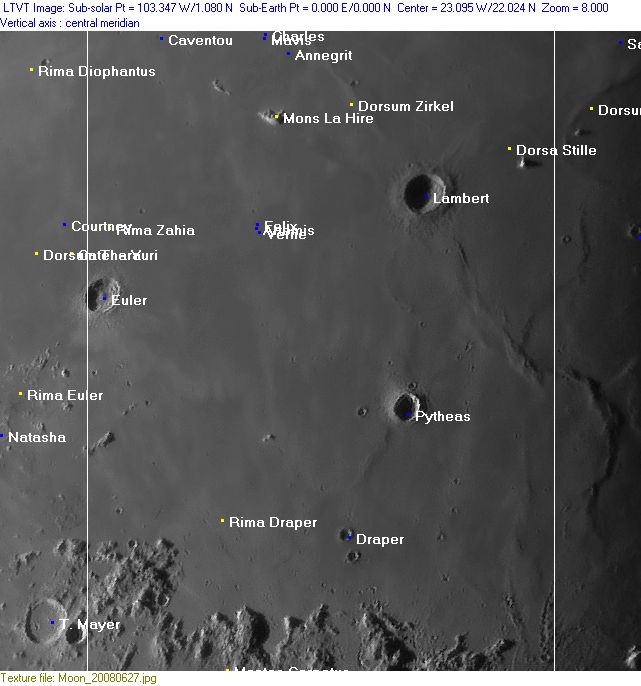Rükl 20
Contents
Rükl Zone 20 - PYTHEAS
Neighboring maps on the Rükl Nearside Map:
| 20 |
||
Photographic Map
(This map is based on an Earth-based photograph that has been computer-corrected to zero libration. The vertical white lines indicate the left and right boundaries of the Rükl rectangle)
Background image source
Named Features
- A new crater on the moon since March 17th, 2013, just north-northwest of the hillock Pytheas Beta, aka Mount Dyson (west of Pytheas itself), see article 17 March 2013 Event.
- Annegrit
- Artemis (in small cluster, with Felix and Verne, south of Mons La Hire) (ejecta-craterlets from Copernicus).
- Cape Banat (a discontinued IAU name).
- Caventou (a very small craterlet, the name Caventou' is printed on the National Geographic Societys revised and reprinted map THE EARTH'S MOON)(2014).
- Charles
- Chopper (a nickname from D.Caes for the irregular cluster of craterlets La Hire C, west of Mons La Hire).
- Dorsa Stille
- Dorsum Lambert (a disallowed name for Lambert R, see Lunar Topographic Orthophotomaps 40-B4, 40-D2).
- Dorsum Pytheas-Draper (an unofficial name from D.Caes for the wrinkle ridge running from Pytheas to Draper).
- Dorsum Zirkel
- Draper
- Euler (Van Langren's Le Pessier, J.Hewelcke's Insula Ficaria).
- Euler Gamma (and its partly buried crater, see Additional Information below).
- Felix (in small cluster, with Artemis and Verne, south of Mons La Hire) (ejecta-craterlets from Copernicus).
- Lambert (Van Langren's Chisletti, J.Hewelcke's Insula Sardinia).
- Mare Imbrium (Van Langren's Mare Austriacum, J.Hewelcke's Mare Mediterraneum) (occupying the whole of Chart 20, except at Montes Carpatus near the lower margin).
- Mavis
- Mons Cratas (J.Hewelcke's disallowed name for the bright ejecta-ray north of Copernicus, running across both Pytheas and Lambert).
- Mons La Hire (Van Langren's Finiae).
- Mons Undest (a disallowed name for the distinct nose shaped hillock Lambert Gamma, printed on Lunar Topographic Orthophotomap 40-B4).
- Mons Whipple (a disallowed name from H.P.Wilkins for the hillock La Hire Alpha, west-northwest of Mons La Hire).
- Montes Carpatus
- Mount Dyson (a disallowed name from H.P.Wilkins for the hillock Pytheas Beta, west of Pytheas).
- Nineteen-West ray (a nickname by D.Caes for the westernmost one of the two pronounced northern rays of Copernicus) (running at approximately 19 degrees West across the southern part of Mare Imbrium).
- Nose (The Nose) (a nickname from D.Caes for the nose-shaped hillock Lambert Gamma, aka Mons Undest).
- Pietrosul Bay (a discontinued IAU name).
- Pytheas (Van Langren's Bazan, J.Hewelcke's Insula Hiera) (note: on the Strasbourg forgery of Van Langren's map this crater was called Barancii).
- Pytheas's mob (a nickname from D.Caes for the cluster of craterlets at 21°10' North/ 22° West) (west-northwest of Pytheas).
- Pytheas's twins (a nickname from D.Caes for the couple of craterlets at 21°50' North/ 22°15' West) (northwest of Pytheas).
- Rima Draper
- Rima Zahia
- Sinus Gay-Lussac (a discontinued IAU name).
- Verne (in small cluster, with Artemis and Felix, south of Mons La Hire) (ejecta-craterlets from Copernicus).
Lettered Crater Locations
(click on the thumbnails to display full-sized images; use browser BACK button to return - the dashed white lines are the midpoints of the Rükl zones)
Full zone with lettered craters:
Lettered craters by quadrants:
| North West |
North East |
| South West |
South East |
Additional Information
- Other online descriptions of features in this Rükl map section:
Euler Gamma and its partly buried crater
- A very interesting telescopic target in this region is the partially buried craterlet at the base of Euler Gamma's southeastern slope. Euler Gamma is the somewhat boot-shaped hill south-southeast of Euler. A drawing of Euler Gamma and its partially buried craterlet is depicted on page 53 of Harold Hill's book A Portfolio of Lunar Drawings. See also: Partially Buried Craters and Craterlets, and page Euler (Additional Information). - DannyCaes Nov 11, 2008
Chains of craterlets
- Many small craterlet-clusters and chains ("herringbones") are noticeable in this part of Mare Imbrium. Almost all of them have a radial tendency toward Copernicus (Rukl: 31), and are located near or at the "beginning" of each one of Copernicus's bright rays. Some of them (the clusters and chains) were included in the book Apollo Over The Moon; a view from orbit (NASA SP-362).- DannyCaes Nov 20, 2008





